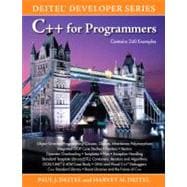
| Preface | p. xxi |
| Before You Begin | p. xli |
| Introduction | p. 1 |
| Introduction | p. 2 |
| History of C and C++ | p. 3 |
| C++ Standard Library | p. 4 |
| Key Software Trend: Object Technology | p. 5 |
| Typical C++ Development Environment | p. 6 |
| Notes About C++ and C++ for Programmers | p. 8 |
| Test-Driving a C++ Application | p. 9 |
| Software Technologies | p. 15 |
| Future of C++: Open Source Boost Libraries, TR1 and C++0x | p. 16 |
| Software Engineering Case Study: Introduction to Object Technology and the UML | p. 16 |
| Wrap-Up | p. 21 |
| Web Resources | p. 22 |
| Introduction to C++ Programming | p. 24 |
| Introduction | p. 25 |
| First Program in C++: Printing a Line of Text | p. 25 |
| Modifying Our First C++ Program | p. 28 |
| Another C++ Program: Adding Integers | p. 29 |
| Arithmetic | p. 33 |
| Decision Making: Equality and Relational Operators | p. 35 |
| (Optional) Software Engineering Case Study: Examining the ATM Requirements Specification | p. 38 |
| Wrap-Up | p. 47 |
| Introduction to Classes and Objects | p. 48 |
| Introduction | p. 49 |
| Classes, Objects, Member Functions and Data Members | p. 49 |
| Overview of the Chapter Examples | p. 51 |
| Defining a Class with a Member Function | p. 52 |
| Defining a Member Function with a Parameter | p. 55 |
| Data Members, set Functions and get Functions | p. 58 |
| Initializing Objects with Constructors | p. 65 |
| Placing a Class in a Separate File for Reusability | p. 69 |
| Separating Interface from Implementation | p. 73 |
| Validating Data with set Functions | p. 79 |
| (Optional) Software Engineering Case Study: Identifying the Classes in the ATM Requirements Specification | p. 84 |
| Wrap-Up | p. 92 |
| Control Statements: Part 1 | p. 93 |
| Introduction | p. 94 |
| Control Structures | p. 94 |
| if Selection Statement | p. 97 |
| ifhellip;else Double-Selection Statement | p. 98 |
| while Repetition Statement | p. 102 |
| Counter-Controlled Repetition | p. 104 |
| Sentinel-Controlled Repetition | p. 108 |
| Nested Control Statements | p. 115 |
| Assignment Operators | p. 118 |
| Increment and Decrement Operators | p. 119 |
| (Optional) Software Engineering Case Study: Identifying Class Attributes in the ATM System | p. 122 |
| Wrap-Up | p. 127 |
| Control Statements: Part 2 | p. 128 |
| Introduction | p. 129 |
| Essentials of Counter-Controlled Repetition | p. 129 |
| For Repetition Statement | p. 131 |
| Examples Using the for Statement | p. 134 |
| Dohellip;while Repetition Statement | p. 139 |
| Switch Multiple-Selection Statement | p. 141 |
| Break and continue Statements | p. 151 |
| Logical Operators | p. 153 |
| Confusing the Equality (==) and Assignment (=) Operators | p. 158 |
| (Optional) Software Engineering Case Study: Identifying Objectsrsquo; States and Activities in the ATM System | p. 159 |
| Wrap-Up | p. 163 |
| Functions and an Introduction to Recursion | p. 165 |
| Introduction | p. 166 |
| Program Components in C++ | p. 167 |
| Math Library Functions | p. 167 |
| Function Definitions with Multiple Parameters | p. 168 |
| Function Prototypes and Argument Coercion | p. 173 |
| Table of Contents provided by Publisher. All Rights Reserved. |
The New copy of this book will include any supplemental materials advertised. Please check the title of the book to determine if it should include any access cards, study guides, lab manuals, CDs, etc.
The Used, Rental and eBook copies of this book are not guaranteed to include any supplemental materials. Typically, only the book itself is included. This is true even if the title states it includes any access cards, study guides, lab manuals, CDs, etc.